
(uk version)
This time, the contemporary art being our temporal space-shuttle, we can thus think that this journey in the time appropriate to every period and style reached an ironic and funny status in 2010. Internet has no gods, that is why we make it what we want. The exoticism also exists in the chronological frieze because the distance which separates us from all those diffrent eras we've been through is at once close and taken away in the future as in past. The distortion pedal effect of the postmodern artist does not hesitate to make uncanny what formerly symbolized the beautiful through a criticism of the representation, of the aesthetic, whom we find in the leaking resin of Nick Van Woert's Venus or in Steven Claydon's ''hand-made " plaster.
Once perceived through a postmodern filter, the object goes out of its antique status. We can even see through these dance, disco contemporary music record covers, the representation of the antique figure of serious clubbers, virile men. While considering clubs as the temples of midnight body and beauty, the enjoyment and the decline, as the Greek or Roman temples knew how to transport the image. Then Kouros was decadent clubbers, and their sound track was electronic, I already begin to see more clear there. All that I can say it is that they have the authentic for them. And the modern in the history?
It is common to speak about novelty when we speak about contemporary art. The eye is always in hunting of the never seen, the new and with static canons, we are entitled to wonder if the result is going on par. This small selection of curated images tends to prove that it is not only up to the historians any more, but also to the artists to reinvent these myths. The new stories presented in the work of AIDS- 3D, Richard Hawkins or Steven Claydon are only strengthening this modern myth in a anachronistic way.
As sign of a time in which we haven't lived, and which thus contains a lot of mysteries and myths in its customs, we are urged to dream about the moon, about the jet packs and of rockets. The bluetooth has no Greek root, the Parthenon came out of a 3D printer.
Joey Villemont
This time, the contemporary art being our temporal space-shuttle, we can thus think that this journey in the time appropriate to every period and style reached an ironic and funny status in 2010. Internet has no gods, that is why we make it what we want. The exoticism also exists in the chronological frieze because the distance which separates us from all those diffrent eras we've been through is at once close and taken away in the future as in past. The distortion pedal effect of the postmodern artist does not hesitate to make uncanny what formerly symbolized the beautiful through a criticism of the representation, of the aesthetic, whom we find in the leaking resin of Nick Van Woert's Venus or in Steven Claydon's ''hand-made " plaster.
Once perceived through a postmodern filter, the object goes out of its antique status. We can even see through these dance, disco contemporary music record covers, the representation of the antique figure of serious clubbers, virile men. While considering clubs as the temples of midnight body and beauty, the enjoyment and the decline, as the Greek or Roman temples knew how to transport the image. Then Kouros was decadent clubbers, and their sound track was electronic, I already begin to see more clear there. All that I can say it is that they have the authentic for them. And the modern in the history?
It is common to speak about novelty when we speak about contemporary art. The eye is always in hunting of the never seen, the new and with static canons, we are entitled to wonder if the result is going on par. This small selection of curated images tends to prove that it is not only up to the historians any more, but also to the artists to reinvent these myths. The new stories presented in the work of AIDS- 3D, Richard Hawkins or Steven Claydon are only strengthening this modern myth in a anachronistic way.
As sign of a time in which we haven't lived, and which thus contains a lot of mysteries and myths in its customs, we are urged to dream about the moon, about the jet packs and of rockets. The bluetooth has no Greek root, the Parthenon came out of a 3D printer.
Joey Villemont
Ici, l'art contemporain est notre navette temporelle, nous pourrions donc penser que ce voyage dans le temps propre à chaque période et style a atteint un statut ironique et humoristique en 2010. Internet n'a pas de dieux, on y fait ce que l'on veut. L'exotisme existe aussi dans la frise chronologique, la distance qui nous sépare de l'antiquité Grecque est à la fois proche et éloignée dans le futur comme dans le passé. L'effet de distorsion propre à l'artiste postmoderne qui n'hésite pas à rendre dérangeant ce qui jadis symbolisait le beau a travers une critique de la représentation esthétique. La résine dégoulinante de la Venus de Nick Van Woert (b.1979) ou le plâtre ''fait main'' de Steven Claydon (b.1969) en témoignent.
Une fois perçu à travers un filtre postmoderne, l'objet sort de son statut antique. Nous pouvons voir à travers ces pochettes de disques présentées ici apparaître la figure antique de sérieux clubbers, d'hommes virils qui nous amèneraient à considérer les ''clubs'' comme des temples de la beauté nocturne, de la joie et de la décadence. Alors les Kouros seraient des clubbers décadents avec leur bande son électronique, ils ont l'authentique pour eux. Et le moderne dans l'histoire ?
La nouveauté tient une place majeur quand il s'agit de création contemporaine. L'amateur est toujours à la recherche de "jamais vu". Avec des cannons aussi statiques que les Kouros, les bustes, les colonnes, les temples, le revival Grec tiendra t-il ses promesses de nouveauté ?
Cette sélection d'images curatées tend à prouver qu'il n'appartient plus seulement aux historiens, mais aussi aux artistes de réinventer les mythes et ce depuis un moment. Ces nouvelles narrations présentes dans l'œuvre de Aids 3D (b.1986, 1985), Richard Hawkins (b.1961) ou Steven Claydon ne font que renforcer ce mythe moderne de façon anachronique. Tant de signes d'une époque que nous n'avons pas vécue, qui renferme bon nombre de mystères. Ce revival de la Grèce antique nous pousse donc à rêver de la lune, de jet packs et de fusées, le bluetooth n'a pas de racine grecque, le Parthénon est sorti d'une imprimante 3D.
Joey Villemont
Une fois perçu à travers un filtre postmoderne, l'objet sort de son statut antique. Nous pouvons voir à travers ces pochettes de disques présentées ici apparaître la figure antique de sérieux clubbers, d'hommes virils qui nous amèneraient à considérer les ''clubs'' comme des temples de la beauté nocturne, de la joie et de la décadence. Alors les Kouros seraient des clubbers décadents avec leur bande son électronique, ils ont l'authentique pour eux. Et le moderne dans l'histoire ?
La nouveauté tient une place majeur quand il s'agit de création contemporaine. L'amateur est toujours à la recherche de "jamais vu". Avec des cannons aussi statiques que les Kouros, les bustes, les colonnes, les temples, le revival Grec tiendra t-il ses promesses de nouveauté ?
Cette sélection d'images curatées tend à prouver qu'il n'appartient plus seulement aux historiens, mais aussi aux artistes de réinventer les mythes et ce depuis un moment. Ces nouvelles narrations présentes dans l'œuvre de Aids 3D (b.1986, 1985), Richard Hawkins (b.1961) ou Steven Claydon ne font que renforcer ce mythe moderne de façon anachronique. Tant de signes d'une époque que nous n'avons pas vécue, qui renferme bon nombre de mystères. Ce revival de la Grèce antique nous pousse donc à rêver de la lune, de jet packs et de fusées, le bluetooth n'a pas de racine grecque, le Parthénon est sorti d'une imprimante 3D.
Joey Villemont
GOING GREEK
By It's Our Playground
By It's Our Playground
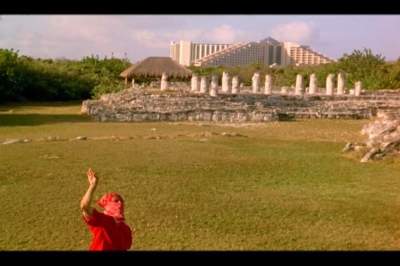




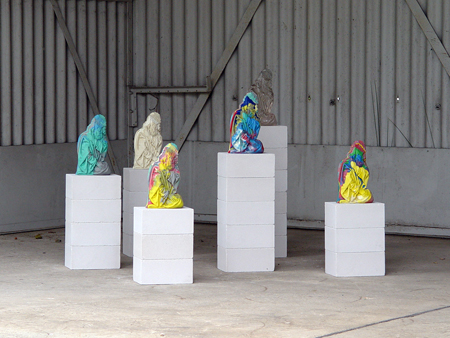

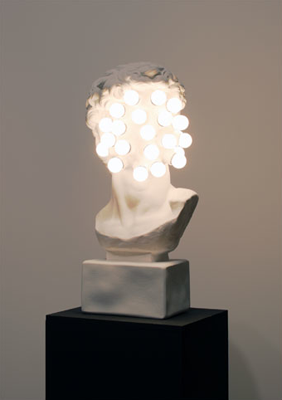
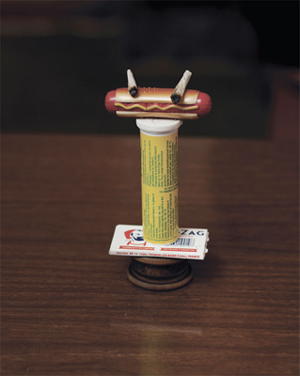
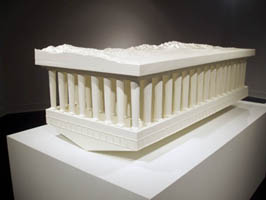
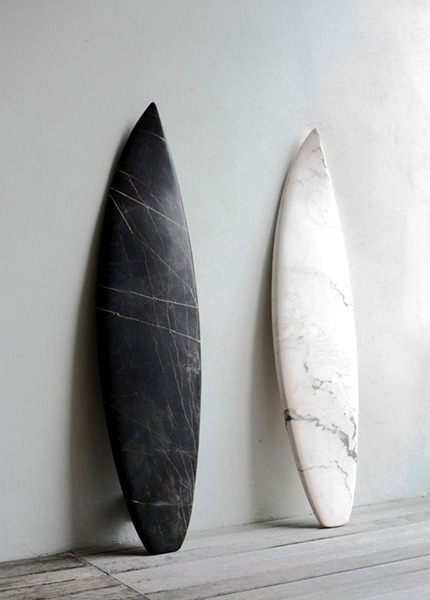
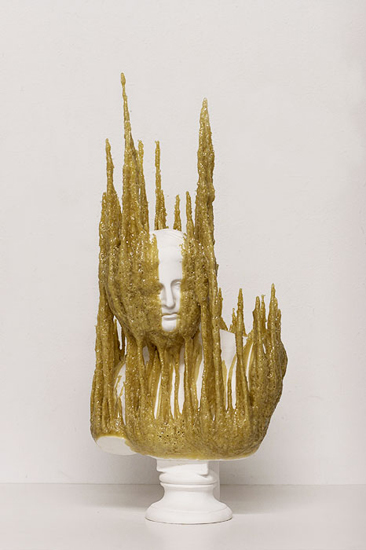
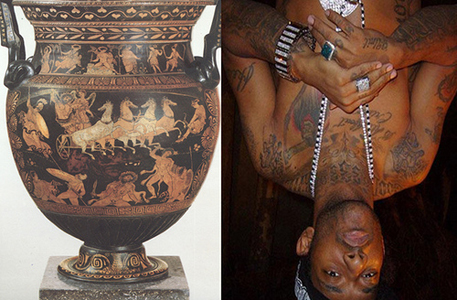
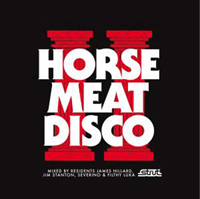
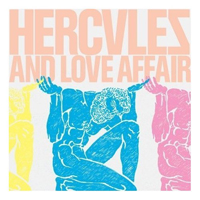

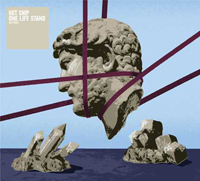
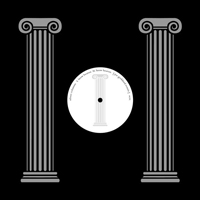
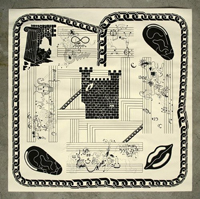
GOING GREEK
06.09.2010
(top left to low right)
Nick Van Woert , Venus 2, 2009.
David Lieske , “Der afrikanische Stuhl von Marcel Breuer und Gunta Stölzl aus der Anfangszeit des Bauhauses 80 Jahre verschollen geglaubt nun aufgefunden und erstmals praesentiert. (fig. IV)”, 2009.
Internet found image.
Internet found image.
Robert Andrade , ''a moon of saturn resting on a doric foundation'' Collaboration wiith Daniel G.Baird, 2007.
Cyprien Gaillard , Cities of Gold and Mirrors, 2009.
Oliver Laric , Icon (Utrecht), 2009.
Reena Spaulings , Mollusk (Rosa Portogallo), 2009.
RECORDS
Hot chip - One life stand, cover 2010
Silver Columns - single cover 2010
Hercules and love affair - s/t, album cover 2008
Zongamin
Horse meat disco - Horse Meat Disco II, album cover 2010
Kisses - People can do the most amazing things (Maman Remixes), album cover 2010
ARP - The Soft wave, album cover 2010
AIDS-3D , Plato with biometric overlay.
Jason Nocito ,
Richard Hawkins
Lindsay Lawson , Anachronism/Lamp, 2008.
Steven Claydon , Atop the Loam (A Forester), 2009.
06.09.2010
(top left to low right)
Nick Van Woert , Venus 2, 2009.
David Lieske , “Der afrikanische Stuhl von Marcel Breuer und Gunta Stölzl aus der Anfangszeit des Bauhauses 80 Jahre verschollen geglaubt nun aufgefunden und erstmals praesentiert. (fig. IV)”, 2009.
Internet found image.
Internet found image.
Robert Andrade , ''a moon of saturn resting on a doric foundation'' Collaboration wiith Daniel G.Baird, 2007.
Cyprien Gaillard , Cities of Gold and Mirrors, 2009.
Oliver Laric , Icon (Utrecht), 2009.
Reena Spaulings , Mollusk (Rosa Portogallo), 2009.
RECORDS
Hot chip - One life stand, cover 2010
Silver Columns - single cover 2010
Hercules and love affair - s/t, album cover 2008
Zongamin
Horse meat disco - Horse Meat Disco II, album cover 2010
Kisses - People can do the most amazing things (Maman Remixes), album cover 2010
ARP - The Soft wave, album cover 2010
AIDS-3D , Plato with biometric overlay.
Jason Nocito ,
Richard Hawkins
Lindsay Lawson , Anachronism/Lamp, 2008.
Steven Claydon , Atop the Loam (A Forester), 2009.
Ashes to Ashes Exhibition at AMP, Athens
